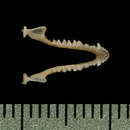en
names in breadcrumbs


There are four subspecies of M. volans, M. volans amotus, occupying the Sierra Transvolcanica Transversal in Mexico, M. volans interior, occuring throughout the central United States and northern Mexico, M. volans longicrus, occuring from southeastern Alaska to western California, and M. volans volans, in peninsular Baja California.
Although this species is relatively widespread, little information exists regarding its biology.
M. volans is one of the largest Myotis species.
More knowledge is needed regarding M. volans' breeding biology, winter distribution, and population trends (Allen, 1974; Nagorsen and Brigham, 1993, Wilson and Ruff, 1999).
Perception Channels: tactile ; chemical
Temperate North American bats are now threatened by a fungal disease called “white-nose syndrome.” This disease has devastated eastern North American bat populations at hibernation sites since 2007. The fungus, Geomyces destructans, grows best in cold, humid conditions that are typical of many bat hibernacula. The fungus grows on, and in some cases invades, the bodies of hibernating bats and seems to result in disturbance from hibernation, causing a debilitating loss of important metabolic resources and mass deaths. Mortality rates at some hibernation sites have been as high as 90%. While there are currently no reports of Myotis volans mortalities as a result of white-nose syndrome, the disease continues to expand its range in North America.
US Federal List: no special status
CITES: no special status
IUCN Red List of Threatened Species: least concern
There are no known negative effects of M. volans, though bat populations do sometimes act as disease vectors.
M. volans populations act to control insect populations, as do those of other bat species.
Emerging at dusk and staying active throughout the night, M. volans takes aerial prey 3 to 4 meters over water, forest clearings, and forest canopy. Their diet consists mostly of moths (75%), but they also feed on termites, spiders, flies, beetles, leafhoppers, and lacewings. The echolocation call consists of a shallow frequency modulated sweep. They are capable of detecting prey at a distance of 5 to 10m. When foraging they follow a repetitive circuit throughout the evening and on consecutive nights (Barbour and Davis, 1969; Nagorsen and Brigham, 1993; Wilson and Ruff, 1999; van Zyll de Jong, 1985).
Long-legged Myotis are distributed throughout much of western North America, from central Mexico to southeastern Alaska and western Canada (Keller, 1987; Nagorsen and Brigham, 1993).
Biogeographic Regions: nearctic (Native )
M. volans are found in forested regions. They establish roosts in trees, rock crevices, fissures in stream banks, and buildings. Caves and mines are not used in the day, but M. volans can be captured there at night (van Zyll de Jong, 1985).
Terrestrial Biomes: forest
Average lifespan
Sex: male
Status: wild: 2.1 years.
Myotis volans range from 83 to 100mm in total length with a wingspan from 215 to 272mm. Fur color varies from reddish-brown to nearly black with the ventral fur being relatively dark. The ventral fur extends onto the underside of the wing to a line joining the elbow and knee. The ears are relatively short (9 to 15mm) with rounded tips and barely extend to the nose when pushed forward. The tragus is long (5 to 7mm) and narrow. The calcar bears a prominent keel and the third metacarpal is longer than the fourth and fifth. The common name is derived from its relatively long tibia and the feet are relatively small. Characteristics of the skull include a short rostrum, steep forhead, broad interorbital region, and globose brain-case. Dental formula is 2/3 1/1 2/3 3/3.
Range mass: 5 to 10 g.
Range length: 83 to 100 mm.
Other Physical Features: endothermic ; heterothermic ; bilateral symmetry
Sexual Dimorphism: sexes alike
Large nursery colonies, which may number in the hundreds, are formed by this species. These colonies occur most commonly in trees. Mating occurs before the bats enter hibernation in late August or September. Mature females produce one offspring, although it is unknown at what age sexual maturity is reached. Time of parturition varies with latitude. Young are born in late June and July. It is speculated that most juvenile males are sexually active. Banded individuals have been recorded living to 21 years of age (Barbour and Davis, 1969; Nagorsen and Brigham, 1993; van Zyll de Jong, 1985).
Range number of offspring: 1 to 1.
Key Reproductive Features: seasonal breeding ; gonochoric/gonochoristic/dioecious (sexes separate); sexual ; viviparous ; sperm-storing
Average number of offspring: 1.
Average age at sexual or reproductive maturity (female)
Sex: female: 152 days.